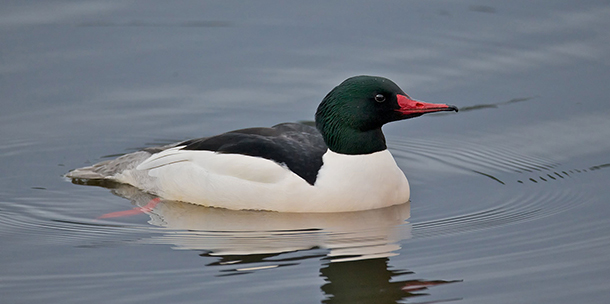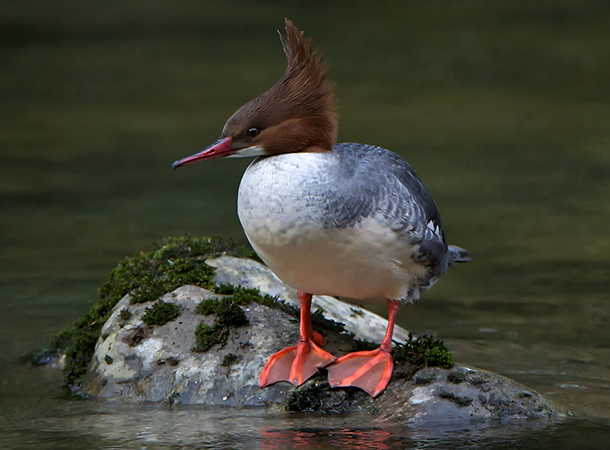BirdNote: Common Mergansers
Air Date: Week of September 9, 2016

A male Common Merganser. (Photo: Gregg Thompson)
A large water bird known as the Common Merganser is often mistaken for a loon, as Michael Stein reports in today’s BirdNote. That’s because they share many physical traits, but the merganser has one adaptation that gives it an edge in catching fish.
Transcript
BirdNote®
Common Mergansers Parallel Loons
CURWOOD: We’re up in the northlands with water and the birds that live on it for BirdNote® today. And as Michael Stein explains, sometimes birds are not what they seem.
[Common Merganser calling - file from Lang Elliott, musicofnature.com]
STEIN: On a northern lake surrounded by dense evergreens, a large water bird rests on the surface. Its long, slim body – more than two feet of it – appears mostly white, the back black, the head a deep green. And all of it glistens. The bird dives under, a graceful sliding motion. Then returns to the surface with a fish grasped firmly in its beak.The bird’s shape and behavior spell “loon.”
[Common Loon brief vocalization, http://macaulaylibrary.org/audio/43039, 0.35-.38]
But this is a male Common Merganser, a very large duck that hunts fish for a living.
[Common Merganser calling, http://macaulaylibrary.org/audio/61558, 0.14-.17]
The Common Merganser is one of our biggest ducks, about the size of some loons, or even a small goose. Although it’s not closely related to loons, it has evolved a similar overall structure and predatory behavior. But a merganser has a unique feature that a loon lacks: tooth-like serrations along the edge of the bill that help the bird grasp slippery fish.

A female Merganser. (Photo: Gregg Thompson)
Common Mergansers nest in the northern states and Canada. So do loons. But loons nest on the ground, while mergansers nest mostly in tree cavities and rock crevices. Cavities big enough to house a hefty 3½-pound female, plus about a dozen jumbo eggs. I’m Michael Stein.
###
Written by Bob Sundstrom
Common Merganser calls recorded by Lang Elliot, musicofnature.com. Common Loon brief vocalization, 43039 and 61558 recorded by William W. H. Gunn, provided by The Macaulay Library of Natural Sounds at the Cornell Lab of Ornithology, Ithaca, New York.
BirdNote’s theme music was composed and played by Nancy Rumbel and John Kessler.
Producer: John Kessler
Executive Producer: Sallie Bodie
© 2016 Tune In to Nature.org September 2016 Narrator: Michael Stein
http://birdnote.org/show/common-merganser
CURWOOD: And for photos, paddle on over to our website, LOE.org.
Links
Living on Earth wants to hear from you!
Living on Earth
62 Calef Highway, Suite 212
Lee, NH 03861
Telephone: 617-287-4121
E-mail: comments@loe.org
Newsletter [Click here]
Donate to Living on Earth!
Living on Earth is an independent media program and relies entirely on contributions from listeners and institutions supporting public service. Please donate now to preserve an independent environmental voice.
NewsletterLiving on Earth offers a weekly delivery of the show's rundown to your mailbox. Sign up for our newsletter today!
 Sailors For The Sea: Be the change you want to sea.
Sailors For The Sea: Be the change you want to sea.
 The Grantham Foundation for the Protection of the Environment: Committed to protecting and improving the health of the global environment.
The Grantham Foundation for the Protection of the Environment: Committed to protecting and improving the health of the global environment.
 Contribute to Living on Earth and receive, as our gift to you, an archival print of one of Mark Seth Lender's extraordinary wildlife photographs. Follow the link to see Mark's current collection of photographs.
Contribute to Living on Earth and receive, as our gift to you, an archival print of one of Mark Seth Lender's extraordinary wildlife photographs. Follow the link to see Mark's current collection of photographs.
 Buy a signed copy of Mark Seth Lender's book Smeagull the Seagull & support Living on Earth
Buy a signed copy of Mark Seth Lender's book Smeagull the Seagull & support Living on Earth

